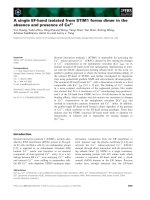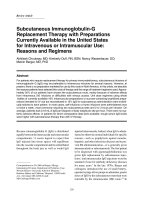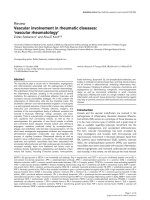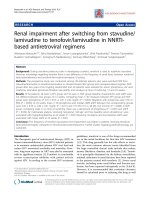Báo cáo y học: "Vascular injuries after minor blunt upper extremity trauma: pitfalls in the recognition and diagnosis of potential "near miss" injuries" ppsx
Bạn đang xem bản rút gọn của tài liệu. Xem và tải ngay bản đầy đủ của tài liệu tại đây (706.66 KB, 6 trang )
BioMed Central
Page 1 of 6
(page number not for citation purposes)
Scandinavian Journal of Trauma,
Resuscitation and Emergency Medicine
Open Access
Review
Vascular injuries after minor blunt upper extremity trauma: pitfalls
in the recognition and diagnosis of potential "near miss" injuries
Jonathan T Bravman
1
, Kyros Ipaktchi
1
, Walter L Biffl
2
and Philip F Stahel*
1
Address:
1
Department of Orthopaedic Surgery, Denver Health Medical Center, University of Colorado School of Medicine, 777 Bannock Street,
Denver, CO 80204, USA and
2
Department of Surgery, Denver Health Medical Center, University of Colorado School of Medicine, 777 Bannock
Street, Denver, CO 80204, USA
Email: Jonathan T Bravman - ; Kyros Ipaktchi - ; Walter L Biffl - ;
Philip F Stahel* -
* Corresponding author
Abstract
Background: Low energy trauma to the upper extremity is rarely associated with a significant
vascular injury. Due to the low incidence, a high level of suspicion combined with appropriate
diagnostic algorithms are mandatory for early recognition and timely management of these
potentially detrimental injuries.
Methods: Review of the pertinent literature, supported by the presentation of two representative
"near miss" case examples.
Results: A major diagnostic pitfall is represented by the insidious presentation of significant upper
extremity arterial injuries with intact pulses and normal capillary refill distal to the injury site, due
to collateral perfusion. Thus, severe vascular injuries may easily be missed or neglected at the upper
extremity, leading to a long-term adverse outcome with the potential need for a surgical
amputation.
Conclusion: The present review article provides an outline of the diagnostic challenges related to
these rare vascular injuries and emphasizes the necessity for a high level of suspicion, even in the
absence of a significant penetrating or high-velocity trauma mechanism.
Background
Upper extremity arterial injuries secondary to minor, non-
penetrating trauma mechanisms, such as low energy trau-
matic joint dislocations, are very rare. In a study of 1,565
upper extremity dislocations, arterial lesions were
detected in 0.97% and 0.47% of all cases with closed
shoulder or elbow dislocations, respectively [1]. Interest-
ingly, this rare entity has been first described in the French
literature almost 100 years ago, and was found to be asso-
ciated with a high mortality due to delayed recognition
and a lack of effective treatment strategies [2]. Elderly
patients appear to be particularly susceptible to vascular
injuries due to loss of arterial elasticity [3]. In this article,
we outline the diagnostic challenges related to these rare
vascular injuries, based on the description of two clinical
"near miss" cases, and provide an updated review of the
pertinent literature.
"Near miss" case #1
A 46 year-old right hand dominant male presented to our
emergency department (ED) after sustaining a fall from
standing height off a curb while intoxicated. The patient
Published: 25 November 2008
Scandinavian Journal of Trauma, Resuscitation and Emergency Medicine 2008, 16:16 doi:10.1186/1757-7241-16-16
Received: 17 October 2008
Accepted: 25 November 2008
This article is available from: />© 2008 Bravman et al; licensee BioMed Central Ltd.
This is an Open Access article distributed under the terms of the Creative Commons Attribution License ( />),
which permits unrestricted use, distribution, and reproduction in any medium, provided the original work is properly cited.
Scandinavian Journal of Trauma, Resuscitation and Emergency Medicine 2008, 16:16 />Page 2 of 6
(page number not for citation purposes)
had a history of recurrent right shoulder dislocations after
low-energy mechanisms. He has been previously treated
conservatively at outside facilities, with closed reduction
and temporary immobilization. On current presentation
to the ED, the patient complained of right shoulder pain.
Clinically, he had a typical deformity consistent with an
anterior shoulder dislocation. This diagnosis was con-
firmed by plain x-rays (Fig. 1A). Neurovascular exam
demonstrated normal (2+) and symmetric radial pulses
with 5/5 motor function and fully intact light touch sen-
sation and 2-point discrimination in the distribution of
the radial, median, and ulnar nerves. Conscious sedation
was administered and closed reduction was carried out
uneventfully in the ED, by a Kocher maneuver (Fig. 1B).
The post-reduction exam revealed an unchanged neurov-
ascular exam, and the plan was made for patient discharge
with elective follow-up in orthopedic clinic. Shortly
before discharge, the new finding of a "pectoral swelling"
was noted. At this time, the orthopedic surgery service was
consulted for concern of a potential pectoralis muscle rup-
ture. Upon the repeat evaluation by the orthopedic team,
an expanding hematoma was appreciated in the axilla and
anterolateral chest wall. Additionally, compared to the
previously documented exam, a change in neurologic sta-
tus was noted with a decrease in light touch sensation in
the distribution of the median and ulnar nerve, while
motor function remained intact. In addition, the right
arm was found to have a mildly hyperemic appearance.
Distal pulses were present and palpable, and the arm-arm
arterial index was measured to be 1.1 (i.e. ipsilateral
blood pressure compared to the contralateral side). Based
on the neurological finding of a "soft sign" for arterial
injury (Table 1), a concern for arterial injury was raised,
and a further diagnostic work-up was initiated. An emer-
gent angiography was performed, which revealed a leak-
ing pseudoaneurysm of the right axillary artery (Fig 2,
arrow). The vascular surgery team was consulted and the
patient was immediately taken to the operating room. The
surgical exploration revealed an avulsion injury to two
posterior and inferiorly directed branches from the base of
the circumflex humeral artery with extension into the axil-
lary artery. These branches were ligated and a primary
repair of the remaining axillary artery defect was per-
formed. Forearm fasciotomies were performed to prevent
an ischemia/reperfusion-mediated compartment syn-
drome. The vascular repair was successful, and the patient
recovered well secondary to a repeat return to the OR for
wound closure of the fasciotomy incisions. On final fol-
low-up in orthopedic clinic, the patient had an intact neu-
rologic exam and well perfused right arm, with strong
palpable symmetric radial pulses.
"Near miss" case #2
A 38 year-old right hand dominant woman presented to
the ED intoxicated, one day after being assaulted. Per the
patient's report, her left arm had been twisted during the
altercation. She complained of left arm pain. Her past
medical history was relevant for chronic alcohol abuse.
On first evaluation, the left arm appeared cooler than the
right arm, and there was a gross deformity and instability
at the elbow joint with an ecchymotic area over the medial
side of the elbow (Fig 3A). Clinically, the patient had a
normal perfusion in her left hand (Fig. 3B). Her neuro-
logic evaluation revealed an intact 5/5 motor function of
the left hand and intact sensation to light touch and 2-
point discrimination. The radial pulse was symmetrically
palpable (2+). The patient was radiographically found to
have a traumatic elbow dislocation (Fig. 4A), which was
Case demonstration of a 46-year-old right hand dominant male who sustained a fall from standing onto the right shoul-derFigure 1
Case demonstration of a 46-year-old right hand dominant
male who sustained a fall from standing onto the right shoul-
der. Injury X-ray demonstrates an anterior shoulder disloca-
tion (panel A) which was successfully reduced in the
emergency department (panel B).
Same case as in figure 1Figure 2
Same case as in figure 1. Angiography demonstrates a trau-
matic axillary artery pseudoaneurysm (arrow).
Scandinavian Journal of Trauma, Resuscitation and Emergency Medicine 2008, 16:16 />Page 3 of 6
(page number not for citation purposes)
successfully reduced upon first attempt under conscious
sedation in the ED (Fig. 4B).
After closed reduction, the radial artery pulse was faintly
palpable, while Doppler signals were robust. The arm-arm
arterial index was found to be pathological, with a value
of 0.7. The patrient's left hand continued to appear well
perfused with a recapillarisation time of <2 seconds. A CT-
angiography was ordered with concern for arterial injury
and revealed an abrupted contrast flow at the level of the
elbow, with collateral reconstitution of vascular flow in
the forearm (Fig. 5, arrow). The patient was taken emer-
gently to the OR for exploration of the antecubital fossa,
revealing a traction-avulsion injury of 5 cm length at the
level of the brachial artery proximal to the bifurcation
(Fig. 6). In addition, the anterior joint capsule was found
to be completely torn. Arterial repair was performed by
interpositional reverse saphenous vein grafting, which re-
established a palpable radial artery pulse. Given the
absence of forearm ischemia prior to the repair, as well as
soft forearm compartments intraoperatively, the decision
was made not to perform a forearm fasciotomy. The arm
was placed in a posterior splint until the wound was
healed, and the patient had an uneventful postoperative
course at follow-up in orthopedic clinic.
Discussion
Traumatic injuries to the axillary and brachial arteries
remain rare, representing 15–20% of arterial injuries to
the upper limb [4]. Approximately 6% of these injuries are
attributable to blunt trauma, with the majority occurring
in the setting of fracture-dislocations. Less than 1% of vas-
cular injuries to the upper extremity are associated with a
traumatic dislocation alone [1]. Elderly patients appear
more susceptible to vascular injuries, with the majority of
reported cases occurring in patients over the age of 50 [3].
Table 1: Clinical signs for prediction of an arterial extremity injury.
"Hard signs" "Soft signs"
Active or pulsatile hemorrhage Asymmetric extremity blood pressures
Pulsatile or expanding hematoma Stable and non-pulsatile hematoma
Clinical signs of limb ischemia Proximity of wound to a major vessel
Diminished or absent pulses Peripheral neurological deficit
Bruit or thrill, suggesting AV-fistula Presence of shock/hypotension
The presence of a "hard sign" of an arterial injury warrants an immediate surgical exploration with the option of an on-table angiography. In contrast,
the "soft signs" are less specific in predicting a significant arterial extremity injury. In exclusive presence of a "soft sign", such as an asymmetric ankle-
brachial-index, the recommended further diagnostic workup includes an angiography or CT-angiography.
Case demonstration of a 38-year-old right hand dominant woman who sustained a twisting injury to her left arm during an assaultFigure 3
Case demonstration of a 38-year-old right hand dominant
woman who sustained a twisting injury to her left arm during
an assault. Clinically, her left elbow showed ecchymosis on
the medial side (panel A). Her ipsilaterla hand remained well
perfused (panel B), with a strong radialis pulse and a normal
capillary refill, despite the presence of a significant arterial
injury.
Same case as in figure 3Figure 4
Same case as in figure 3. X-rays before (panel A) and after
(panel B) closed reduction of a left elbow dislocation.
Scandinavian Journal of Trauma, Resuscitation and Emergency Medicine 2008, 16:16 />Page 4 of 6
(page number not for citation purposes)
Interestingly, up to a third of all patients have a history of
previous joint dislocations, suggesting arterial incarcera-
tion in scar tissue, which may render the vessel more sus-
ceptible to injury during a subsequent dislocation [5].
Several potential mechanisms relating to the particular
regional anatomy have been postulated which may
account for upper extremity vascular injuries. The axillary
artery is typically divided into three segments relative to
its relationship with the pectoralis minor muscle. The
third segment – defined as the portion distal to the lower
edge of the pectoralis minor – appears to be most fre-
quently injured (86%) [6]. Adoriasio [4] and Milton [7]
independently proposed a mechanism by which the axil-
lary artery is exposed to direct injury by the dislocating
humeral head, given its relatively fixed anatomical posi-
tion between the subscapular and humeral circumflex
arteries. Multiple authors have additionally proposed a
mechanism by which the pectoralis minor muscle acts as
fulcrum for the artery, thus enabling a vascular injury by
kinking, shearing or compression [3,6,8,9]. Although axil-
lary artery injuries are fairly common, fewer than 50 cases
related to anterior shoulder dislocations have been
reported in the literature, to our knowledge [3,4,10-20].
A major contributing factor for brachial artery injuries at
the elbow region is related to a vascular entrapment
underneath the lacertus fibrosus in the antecubital fossa.
This anatomical relation explains the high incidence of
brachial artery injuries proximal to the bifurcation, due to
the relative immobility of the artery which prohibits a lon-
gitudinal excursion to compensate for forearm rotation
about the elbow secondary to elbow dislocations and dis-
tal humerus fractures [21]. The elbow has a circumferen-
tial "network" of collaterals which feed the radial and
ulnar recurrent and interosseus vessels, even in the
absence of brachial artery flow. This circumstance
explains the relative success of the historical practice of
ligation of brachial and/or radial and ulnar arteries in
elbow dislocations performed to control posttraumatic
bleeding intraoperatively [22].
A pathognomonic "triad" has been described to diagnose
vascular lesions in shoulder dislocations, consisting of
anterior shoulder dislocation, expanding axillary
hematoma and diminished peripheral pulse [3]. Simi-
larly, in closed elbow dislocations, the absence of a radial
pulse has been noted to be main predicting factor of an
arterial injury [23]. As outlined by the two representative
cases in the present paper, the reliance on peripheral
pulses alone can be misleading. Sparks et al. described 30
patients with absent peripheral pulses and clinical signs of
ischemia, of which only 12 cases were found to have arte-
rial injuries by angiography [1]. On the other hand, palpa-
ble distal pulses or pulses detected by Doppler ultrasound
may be present even in the instance of complete arterial
disruption, due to abundant collateral flow [24,25].
Therefore, the physical exam alone is generally regarded as
inadequate for diagnosis of peripheral vascular injury in
extremity trauma and has been shown to be a poor predic-
tor of arterial injuries [26-28]. In fact, the "classic" signs of
arterial insufficiency may be absent in up to 40% of
patients with upper extremity joint dislocations [1,29].
Clinical signs of arterial injury have been stratified based
on their predictive value into "hard" and "soft" signs
(table 1). The presence of a "hard" sign of vascular injury
Same case as in figures 3, 4Figure 5
Same case as in figures 3, 4. CT-angiography with 3D-recon-
struction demonstrating a 4 to 5 cm long brachial artery lac-
eration at the elbow (arrow) with reconstitution of forearm
vessel flow via collateral perfusion.
Same case as in figures 3, 4, 5Figure 6
Same case as in figures 3, 4, 5. The intraoperative finding cor-
relates to preoperative CT-angiography, revealing a brachial
artery traction injury of about 5 cm length, located proximal
to the bifurcation.
Scandinavian Journal of Trauma, Resuscitation and Emergency Medicine 2008, 16:16 />Page 5 of 6
(page number not for citation purposes)
mandates an immediate surgical exploration and vascular
repair [26,30-32]. In contrast, clinical "soft" signs (table
1) are much less specific in the diagnosis of a significant
arterial injury, and have been found to lack an adequate
predictive value [26,33].
Management strategies for patients with vascular injuries
have gradually changed over time. During wartimes, a
protocol of operative exploration was advocated based on
the proximity of injury alone. This concept was aban-
doned when it became apparent that such a paradigm was
not transferable to low-velocity civilian injuries due a low
efficiency [32,34,35]. In the 1970's and 80's, arteriogra-
phy became the "gold standard", and was abandoned
more recently, due to invasive risks of iatrogenic compli-
cations and the observation that the angiographic screen-
ing rarely led to a change in patient managemen
[33,34,36-41]. Doppler ultrasound was demonstrated to
be an effective diagnostic tool, albeit its sensitivity being
highly operator-dependent [30,42,43]. More recently, the
"arterial pressure index" (API) – also described as the
"ankle-brachial index" (ABI) or the "ankle-arm index"
(AAI) – has become a new standard as a screening tool in
the potentially vascular injured limb [39,41]. The API is
performed by placing a blood pressure cuff just above the
ankle or wrist of the injured limb and the systolic pressure
is determined by Doppler probe at the respective dorsalis
pedis or radial artery. Identical measurement is performed
on an uninjured limb and the API is calculated by divid-
ing the systolic pressure in the injured limb by the systolic
pressure in the uninjured limb. This tool has been vali-
dated in the setting of penetrating and blunt extremity
injuries [39,41,44]. An API value of < 0.9 was found to
have a sensitivity of 95% and specificity of 97% for a
major arterial extremity injury [41]. A different study on
blunt orthopaedic extremity injuries described the nega-
tive predictive value of 100% for an API > 0.9 to exclude
an arterial injury [44]. In the present paper, only one of
two cases had a pathological API of 0.7, while the first
patient described in this report here had a misleading API
of 1.1, suggesting the absence of an arterial injury. In
recent years, CT-angiography (CT-A) has come to play an
increasing role in diagnosing suspected peripheral artery
injuries. Compared to traditional angiography, as the pre-
vious "gold standard", modern CT-A using multislice fine
resolution technique has been shown to be less invasive,
while yielding a similar diagnostic sensitivity and a more
widespread availabilty in the acute workup of trauma
patients [45].
Multiple treatment options have been described for arte-
rial injuries associated with extremity trauma. Case
reports describe successful outcomes using endovascular
techniques employing thrombolysis and stent placement
[13]. However, most authors agree that the most adequate
treatment modality remains in the surgical exploration
with the intraoperative option of a thrombectomy, end-
to-end anastamosis, saphenous vein graft or prosthetic
allograft, with ligation of avulsed collaterals [1]. Prophy-
lactic forearm fasciotomies should be performed in all
ischemic limbs due to the high risk of postoperative com-
partment syndrome secondary to reconstitution of arterial
flow, leading to ischemia/reperfusion syndrome.
Unfortunately, until present, there is no established or
putative algorithm available which may allow the
straight-forward clinical work-up for discrimination and
identification of those rare patients who sustained a sig-
nificant vascular injury after minor blunt upper extremity
trauma. Obviously, a full work-up by CT-angiography for
every single patient presenting to the emergency depart-
ment for a traumatic shoulder or elbow dislocation is nei-
ther feasible, nor cost-effective. Thus, the emergency
physician in charge of these patients in the first place must
have a high level of suspicion, in conjunction with the
knowledge on the "hard signs" of vascular injuries, as out-
lined in table 1. While common clinical knowledge
implies that a significant vascular injury may require the
history of either a high-energy blunt trauma, or a penetrat-
ing trauma mechanism, as a prerequisite, we clearly dis-
miss this notion in the present paper. Key to success is the
awareness of potentially detrimental vascular injuries in
minor upper extremity trauma, combined with the knowl-
edge of "hard clinical signs" of vascular injury which will
mandate immediate further work-up, with a high likeli-
hood of the need for surgical intervention.
Conclusion
Vascular injuries in low energy trauma are rare and are
easily missed. A high level of suspicion, in conjunction
with the knowledge of sensitive and specific clinical signs,
is paramount for an accurate and timely diagnosis. A thor-
ough physical exam, including determination of the API,
is crucial in the early assessment of a patient with concern
for a vascular extremity injury. Based on the presence or
absence of "hard" clinical signs of arterial injury, an early
indication must be placed for immediate surgical explora-
tion versus additional diagnostic interventions, such as an
arteriography or CT-A. In contrast, simple observation
represents the prerequisite for a detrimental outcome,
since time is of the essence in recognition and manage-
ment of these rare injuries with a potential for high mor-
bidity and mortality.
Competing interests
The authors declare that they have no competing interests.
Authors' contributions
JTB and KI wrote the first draft of the manuscript. WLB
and PFS revised the manuscript and performed the final
Scandinavian Journal of Trauma, Resuscitation and Emergency Medicine 2008, 16:16 />Page 6 of 6
(page number not for citation purposes)
editing. KI and PFS provided the two clinical case exam-
ples. All authors read and approved the final version of
the manuscript.
Consent
Written informed consent was obtained by the two
patients presented in this paper for publication of their
individual case reports.
References
1. Sparks SR, DeLaRosa J, Bergan JJ, Hoyt DB, Owens EL: Arterial
injury in uncomplicated upper extremity dislocations. Ann
Vasc Surg 2000, 14(2):110-113.
2. Guibe M: Des lesions des vaisseaux de l'aisselle qui compli-
quant les luxation de l'epaule. Rev Chir Orthop Reparatrice Appar
Mot 1911, 44:582.
3. Kelley SP, Hinsche AF, Hossain JF: Axillary artery transection fol-
lowing anterior shoulder dislocation: classical presentation
and current concepts. Injury 2004, 35(11):1128-1132.
4. Adoriasio RVE, Sgarbi G: Arterial injury of the axilla, an unusual
case after blunt trauma of the shoulder. J Trauma 1996,
41:754-756.
5. Jardon OM, Hood LT, Lynch RD: Complete avulsion of the axil-
lary artery as a complication of shoulder dislocation. J Bone
Joint Surg Am 1973, 55(1):189-192.
6. Gates JD, Knox JB: Axillary artery injuries secondary to ante-
rior dislocation of the shoulder. J Trauma 1995, 39(3):581-583.
7. Milton GW: The circumflex nerve and dislocation of the shoul-
der. Br J Phys Med 1954, 17(6):136-138.
8. Brown FW, Navigato WJ: Rupture of the axillary artery and bra-
chial plexus palsy associated with anterior dislocation of the
shoulder. Report of a case with successful vascular repair.
Clin Orthop Relat Res 1968, 60:195-199.
9. Gibson J: Rupture of the axillary artery. J Bone Joint Surg Br 1962,
44(B):116.
10. Maweja S, Sakalihasan N, Van Damme H, Limet R: Axillary artery
injury secondary to anterior shoulder dislocation: report of
two cases. Acta Chir Belg 2002, 102(3):187-191.
11. Onyeka W: Anterior shoulder dislocation: an unusual compli-
cation. Emerg Med J 2002, 19(4):367-368.
12. Julia J, Lozano P, Gomez F, Corominas C: Traumatic pseudoaneu-
rysm of the axillary artery following anterior dislocation of
the shoulder. Case report. J Cardiovasc Surg (Torino) 1998,
39(2):167-169.
13. Zanchetta M, Rigatelli G, Dimopoulos K, Pedon L, Zennaro M,
Maiolino P: Endoluminal repair of axillary artery and vein rup-
ture after reduction of shoulder dislocation. A case report.
Minerva Cardioangiol 2002, 50(1):69-73.
14. Popescu D, Fernandez-Valencia JA, Combalia A: Axillary arterial
thrombosis secondary to anterior shoulder dislocation. Acta
Orthop Belg 2006, 72(5):637-640.
15. Razif MA, Rajasingam V: Anterior shoulder dislocation with axil-
lary artery and nerve injury. Med J Malaysia 2002, 57(4):496-498.
16. Allie B, Kilroy DA, Riding G, Summers C: Rupture of axillary
artery and neuropraxis as complications of recurrent trau-
matic shoulder dislocation: case report. Eur J Emerg Med 2005,
12(3):121-123.
17. Stahnke M, Duddy MJ: Endovascular repair of a traumatic axil-
lary pseudoaneurysm following anterior shoulder disloca-
tion. Cardiovasc Intervent Radiol 2006, 29(2):298-301.
18. Helm AT, Watson JS: Compression of the brachial plexus in a
patient with false aneurysm of the axillary artery as a result
of anterior shoulder dislocation. J Shoulder Elbow Surg 2002,
11(3):278-279.
19. Emadian SM, Lee WW: Axillary artery pseudoaneurysm and
axillary nerve palsy: delayed sequelae of anterior shoulder
dislocation. Am J Emerg Med 1996, 14(1):108-109.
20. Orecchia PM, Calcagno D, Razzino RA: Ruptured axillary pseu-
doaneurysm from chronic shoulder dislocation. J Vasc Surg
1996, 24(3):499-500.
21. Marcheix B, Chaufour X, Ayel J, Hollington L, Mansat P, Barret A,
Bossavy JP: Transection of the brachial artery after closed pos-
terior elbow dislocation. J Vasc Surg 2005, 42(6):1230-1232.
22. Eliason ED, Brown RB: Posterior dislocation at the elbow with
rupture of the radial and ulnar arteries. Ann Surg
1937,
106:1111-1115.
23. Endean ED, Veldenz HC, Schwarcz TH, Hyde GL: Recognition of
arterial injury in elbow dislocation. J Vasc Surg 1992,
16(3):402-406.
24. Drury JK, Scullion JE: Vascular complications of anterior dislo-
cation of the shoulder. Br J Surg 1980, 67(8):579-581.
25. Gugenheim S, Sanders RJ: Axillary artery rupture caused by
shoulder dislocation. Surgery 1984, 95(1):55-58.
26. Frykberg ER, Dennis JW, Bishop K, Laneve L, Alexander RH: The
reliability of physical examination in the evaluation of pene-
trating extremity trauma for vascular injury: results at one
year. J Trauma 1991, 31(4):502-511.
27. Perry MO, Thal ER, Shires GT: Management of arterial injuries.
Ann Surg 1971, 173(3):403-408.
28. Graves M, Cole PA: Diagnosis of peripheral vascular injury in
extremity trauma. Orthopedics 2006, 29(1):35-37.
29. Cikrit DF, Dalsing MC, Bryant BJ, Lalka SG, Sawchuk AP, Schulz JE: An
experience with upper-extremity vascular trauma. Am J Surg
1990, 160(2):229-233.
30. Anderson RJ, Hobson RW 2nd, Padberg FT Jr, Swan KG, Lee BC,
Jamil Z, Breitbart G, Manno J: Penetrating extremity trauma:
identification of patients at high-risk requiring arteriogra-
phy. J Vasc Surg 1990, 11(4):544-548.
31. Anderson RJ, Hobson RW 2nd, Lee BC, Manno J, Swan KG, Padberg
FT Jr, Jamil Z, Cambria RA, Breitbart GB: Reduced dependency on
arteriography for penetrating extremity trauma: influence
of wound location and noninvasive vascular studies. J Trauma
1990, 30(9):1059-1063. discussion 1063-1055.
32. Turcotte JK, Towne JB, Bernhard VM: Is arteriography necessary
in the management of vascular trauma of the extremities?
Surgery 1978, 84(4):557-562.
33. Frykberg ER, Vines FS, Alexander RH: The natural history of clin-
ically occult arterial injuries: a prospective evaluation. J
Trauma 1989, 29(5):577-583.
34. Rose SC, Moore EE: Trauma angiography: the use of clinical
findings to improve patient selection and case preparation. J
Trauma 1988, 28(2):240-245.
35. Geuder JW, Hobson RW 2nd, Padberg FT Jr, Lynch TG, Lee BC, Jamil
Z: The role of contrast arteriography in suspected arterial
injuries of the extremities. Am Surg 1985, 51(2):89-93.
36. Bunt TJ, Malone JM, Moody M, Davidson J, Karpman R: Frequency
of vascular injury with blunt trauma-induced extremity
injury. Am J Surg 1990, 160(2):226-228.
37. Weaver FA, Yellin AE, Bauer M, Oberg J, Ghalambor N, Emmanuel
RP, Applebaum RM, Pentecost MJ, Shorr RM: Is arterial proximity
a valid indication for arteriography in penetrating extremity
trauma? A prospective analysis. Arch Surg 1990,
125(10):1256-1260.
38. Hughes CW: Arterial repair during the Korean war. Ann Surg
1958, 147(4):555-561.
39. Johansen K, Lynch K, Paun M, Copass M: Non-invasive vascular
tests reliably exclude occult arterial trauma in injured
extremities. J Trauma 1991, 31(4):515-519. discussion 519–522.
40. Kendall RW, Taylor DC, Salvian AJ, O'Brien PJ: The role of arteri-
ography in assessing vascular injuries associated with disloca-
tions of the knee. J Trauma 1993, 35(6):875-878.
41. Lynch K, Johansen K: Can Doppler pressure measurement
replace "exclusion" arteriography in the diagnosis of occult
extremity arterial trauma? Ann Surg 1991, 214(6):737-741.
42. Meissner M, Paun M, Johansen K: Duplex scanning for arterial
trauma. Am J Surg 1991, 161(5):552-555.
43. Panetta TF, Hunt JP, Buechter KJ, Pottmeyer A, Batti JS: Duplex
ultrasonography versus arteriography in the diagnosis of
arterial injury: an experimental study. J Trauma 1992,
33(4):627-635. discussion 635-626.
44. Mills WJ, Barei DP, McNair P:
The value of the ankle-brachial
index for diagnosing arterial injury after knee dislocation: a
prospective study. J Trauma 2004, 56(6):1261-1265.
45. Peng PD, Spain DA, Tataria M, Hellinger JC, Rubin GD, Brundage SI:
CT angiography effectively evaluates extremity vascular
trauma. Am Surg 2008, 74(2):103-107.









